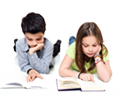Kieber-King, Cynthia
Told in rhyming narrative, Habitat Spy invites children to search for and find plants, invertebrates, birds, and mammals and more that live in 13 different habitats: backyard, beach, bog, cave, desert, forest, meadow, mountain, ocean, plains, pond, river, and cypress swamp. Children will spend hours looking for and counting all the different plants and animals while learning about what living things need to survive.

